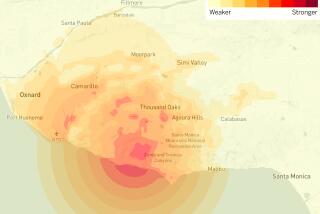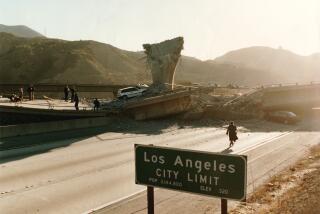1933 Long Beach temblor defined Southern California as ‘earthquake country’
Seventy-five years ago today, at 5:54 p.m., the Long Beach earthquake struck -- and Southern California is still feeling the aftershocks.
Leo Vander Lans was riding in the family car down what is now Long Beach Boulevard when the ground began to shake.
“I recall looking out the right-hand side of the car and this building, this brick building, collapsed,” said Vander Lans, 82, a semi-retired attorney still living in Long Beach. “The bricks were falling, including on the car.”
Vander Lans and his family were not injured. But as they watched, falling bricks struck and killed a man.
“I think we all sat there and prayed a while,” Vander Lans said. “You could hear the bricks pounding everywhere.”
The great quake of 1933 helped define the region’s reputation as “earthquake country.” It was the first destructive quake to occur in the region after a period of rapid growth in the early 20th Century. The violent shaking traumatized newcomers -- many of them transplants from the less seismically active Midwest -- and caught government unaware. In the end, the 1933 quake changed the landscape, leading to improved school construction standards and a heightened awareness of earthquake risks.
“It was a very big political event and a very big event in terms of the development of California seismology,” said Lucy Jones, a seismologist with the U.S. Geological Survey in Pasadena.
The 1933 quake, which occurred on the 46-mile-long Newport-Inglewood Fault, was estimated at magnitude 6.3, far weaker than the estimated 8.3-magnitude earthquake that devastated San Francisco in 1906.
Southern California was just starting to grow in 1933, with people flocking to Long Beach, a seaport surrounded by orange groves and fields.
“The whole of the Los Angeles area was pretty sparsely populated at that time. There wasn’t that much to knock down,” said state geologist John Parrish.
That is not true today -- a fact that concerns scientists. Since 1933, land above the fault line has seen dramatic dense growth -- from the suburban neighborhoods of Huntington Beach to the skyscrapers of Century City.
Seismologists believe a major quake now would cause many times more destruction.
Stanford University researchers have concluded that the Newport-Inglewood fault is capable of producing a 7.0 quake. Their study estimated the such a quake could result in 3,000 to 8,000 deaths and cause $175 billion to $220 billion in losses.
When the 1933 earthquake hit, its epicenter was south of Long Beach, near Huntington Beach, and the then-rudimentary seismographs were maxed out.
The earthquake lasted less than 15 seconds, but powerful aftershocks twisted roofs and toppled chimneys, causing at least $45 million in damage (about $730 million in today’s dollars) and killing some 115 people. A major problem was with unreinforced brick buildings that could not withstand the shaking. State rules in the wake of the 1933 quake would eventually prohibit such buildings.
Had the earthquake struck earlier in the day, the death toll would have been much higher: Among the scores of buildings destroyed were 70 schools. One of those ruined schools was Horace Mann Elementary, where Dorothy Wise, 81, remembers going to class in stuffy canvas tents after the earthquake.
Students there learned a song, sung to the tune of “Yankee Doodle Dandy”:
“We had a quake in ’33
That sent the earth a-shaking
They told us not to be afraid
The earth was in its making.”
Wise’s father had moved the family to Long Beach from South Dakota a few years before, hoping to ease her older sister’s ear infections.
He and his brothers, one of whom later became mayor, opened two Wagner Drug Co. pharmacies. The family lived in a two-bedroom house in the Belmont Heights neighborhood, one of the few with electricity.
The earthquake toppled their chimney and ruptured gas lines, Wise said, but the power stayed on. Her mother used the electric stove to make spaghetti for the neighborhood.
Wise remembers her mother driving her around after the earthquake to survey the damage on 10th and Anaheim streets.
“The part that fascinated me was the apartments,” Wise said.
“The front was just sheared off, and you could see the bathtubs and the toilets, and to me that was just shocking.”
The earthquake shook oil derricks out of the ground in Huntington Beach and shattered windows in downtown Los Angeles, littering streets with glass.
Scores of Long Beach residents were suddenly homeless. They camped out at public parks in tents provided by the Red Cross.
Their plight drew national attention. President Franklin Roosevelt offered assistance. Military commanders sent in 4,000 Marines and sailors from the offshore battle fleet to aid recovery efforts.
The Red Cross received $480,000 in donations from across the country and distributed an average of $138 per family, the equivalent of $2,240 today.
California legislators also reacted swiftly.
Within a month of the earthquake, they passed the Field Act, legislation that would become the earthquake’s major legacy.
The Field Act required tougher building standards for new schools, from elementary schools through community colleges, and retrofitting for older schools.
As a result, subsequent earthquakes have caused fewer deaths, even compared with other countries with stringent building standards such as Japan, said Richard Little, director of the Keston Institute for Public Finance and Infrastructure Policy at USC.
But state universities are exempted from the Field Act, and some other school officials are lobbying to be exempted, too, arguing the stringent seismic standards require excessive inspections and expense.
Jones, the seismologist, credits the law with preventing earthquake damage and hopes legislators expand it to include state universities rather than exempting more schools.
Jones notes that the Northridge earthquake in 1994 caused minimal damage at Los Angeles Mission College, which is covered by the Field Act, but $405 million in damage at Cal State Northridge, which is not covered.
“It has saved our children’s lives, and it saves the state a lot of money,” Jones said.
Today, officials will gather at Long Beach City Hall to commemorate the 75th anniversary of the quake and discuss earthquake safety.
The meeting begins at 5:54 p.m. -- the moment the great quake struck.
molly.hennessy-fiske@ latimes.com
More to Read
Start your day right
Sign up for Essential California for news, features and recommendations from the L.A. Times and beyond in your inbox six days a week.
You may occasionally receive promotional content from the Los Angeles Times.







